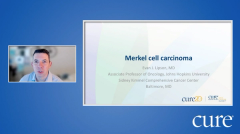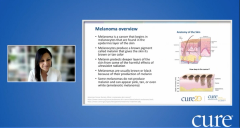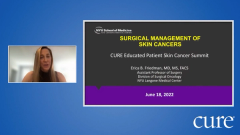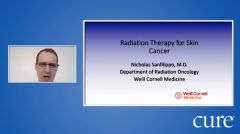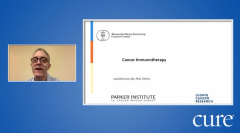
Educated Patient® Skin Cancer Summit Melanoma Presentation: June 18, 2022
Watch Dr. Sunandan Chandra, from Northwestern University Feinberg School of Medicine, discuss the basics of melanoma, during the CURE Educated Patient Skin Cancer Summit.
Melanoma can be an aggressive form of skin cancer; however, looking for early signs and understanding treatment options after diagnosis can help a patient achieve better outcomes, according to an expert.
Dr. Sunandan Chandra, associate professor in the Division of Hematology Oncology at Northwestern University Feinberg School of Medicine in Chicago, discussed the importance of understanding the risks of melanoma, how to conduct self-exams and important steps to take after a diagnosis further at the CURE® Educated Patient® Skin Cancer Summit.
“At the end of the day, increased surveillance, trying to catch skin cancer at an earlier stage, can lead to better outcomes. So, the more on top of surveillance a person can be, I think the better the chances that person will (have),” she said during an interview with CURE®.
Risk Factors and Signs
Melanoma is the fifth most common cancer in the United States and there is expected to be approximately 100,000 cases diagnosed this year, Chandra said. Risk factors for melanoma include UV light exposure (UVA and UVB); indoor tanning; moles; fair skin; freckles and light-colored hair; already having a personal history or family history of melanoma; having a compromised immune system, such as those who received a solid organ transplant and those with chronic lymphocytic leukemia or HIV; older age (65 years and above); male gender; race or ethnicity; and inherited conditions such as xeroderma pigmentosum and hereditary breast or ovarian cancer syndromes.
If a patient is at risk, Chandra recommends seeing a dermatologist, specifically someone who specializes in skin cancer. They should be getting regular skin checkups based on skin type and risk factors.
“In general, patients should also be looking for any spots on their skin that follows the ABCDE mnemonic. … And if any of those parameters are met, I would recommend seeing a dermatologist,” she said.
The ABCDE’s of melanoma are a way for people to look at different moles or spots on their skin and see if it could be a concern. If there is a spot, lesion or mole, then patients should look for:
- Asymmetry – one half is unlike the other half.
- Border is irregular, scalloped or poorly defined.
- Color is varied from one area to another, has shades of tan, brown or black or is sometimes white, red or blue.
- Diameter – melanoma is usually greater than 6 millimeters (the size of a pencil eraser) when diagnosed but could be smaller.
- Evolving – a mole or skin lesion that looks different from the rest or is changing in size, shape or color.
After Diagnosis
In earlier stages, treatment would include wide local excision by a surgeon and in even smaller spots it can be removed by a dermatologic surgeon. And then patients who have received a stage 2 or higher diagnosis should be referred to a medical oncologist who can guide a treatment plan. For those patients there are some Food and Drug Administration (FDA) drugs approved for post-surgery to potentially reduce the risk of recurrence.
“In the preventative setting, in stage 2 and stage 3, we certainly have therapies now that are approved to be given to people to reduce the risk of recurrence,” Chandra noted. “In unresectable or advanced stage 4 melanoma, we also have a number of FDA-approved therapies that have proven to be very beneficial in treating melanoma.”
And all of these approvals have come from results of clinical trials, Chandra added, and there is more to come. Patients with melanoma should know there is potential for them to join a clinical trial which might benefit them.
“These have now resulted in meaningful survival, which we would have never been able to dream of a decade ago. And so, one thing for people with melanoma to keep in mind is to talk to their doctors about potential clinical trials that may be being conducted for their particular type of cancer. Sometimes these clinical trials give them access to drugs that they might not have had access to before,” she explained.
Additionally, patients should be actively working and communicating with their multidisciplinary care team, which may include a dermatologist, surgeon, medical oncologist and, for some, a radiation oncologist.
“(They) should be really working with their care team members and establishing a multidisciplinary team and then following that team’s recommendations and follow-ups, I think that’s really important,” she concluded.
For more news on cancer updates, research and education, don’t forget to

